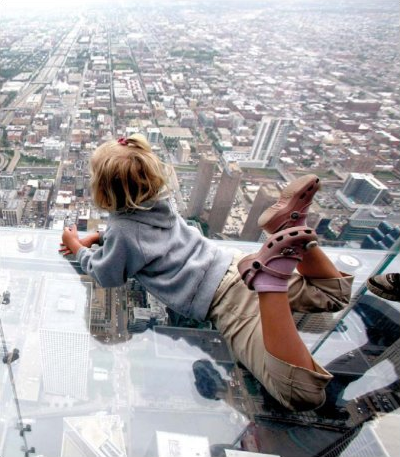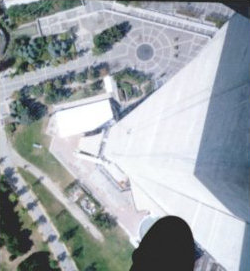I saw this picture on the front page of the Express on my way to work this morning, and it scared the heck out of me at first:

Photo: Kichiro Sato/AP
After all, here was this child on what appeared to be an open ledge, high over a city. It even gave me that funny feeling I get in my stomach whenever I see a long drop down. Then I saw the caption:
Anna Kane, 5, of Alton, Ill. looks down from “The Ledge,” the new glass balconies suspended 1,353 feet in the air and jut out four feet from the Sears Tower’s 103rd floor Skydeck. A sneak preview gave visitors the breathtaking impression that they were floating over the city Wednesday, a day before the balconies open to the public.
And after reading that, I looked at the photo again, and got that weird feeling again. The way that photo looks, it still looked wide open. I think it’s because the way the photo is cropped, it was hard to tell that there was a front on the balconies. The way it looks, one would think that if Ms. Kane got too close to the edge, she would have a 103-story fall to the street below. Not fun. On the Metro this morning, I was trying to convince myself that there had to be some sort of safety mechanism to keep people from making that big fall to the street below, but didn’t see one.
Then after work, I went digging around online, and found this:

Photo: Scott Olson-Getty Images
And then it all made sense. This was a little glassed-in room on the Sears Tower‘s Skydeck. Aha…
I guarantee you, though, even if I go up the Sears Tower again the next time I’m in Chicago, there is no way in hell that I’m standing on the glass. I’ll peer down over the glass from the real floor, but I’m not standing on it. According to an article in the Chicago Sun-Times, the weight tolerance is five tons, as they figured out how much weight you could get on there, and then doubled it. So this could technically support an elephant, weighing in at 7,700 pounds. And I’m still not getting on there. I don’t care how thick the glass is, or how much weight it can support. No.
That brings me back to about 1999. That’s when I got to go to Toronto, and went up the CN Tower. There, they had a big glass floor where you could see down:

That’s a long way down. And even though, according to the woman from the BBC who was filming a documentary that day, it “could support the weight of fourteen hippopotamuses,” I still wasn’t getting on there. I was even nervous walking on the section of non-glass floor in between the sections of glass floor. Something about being able to see where you’ll end up if that floor gives out just gives me the jibblies.
Meanwhile, Metro is now sandwiching Rohrs between cars of other classes. However, as I mentioned earlier, they might want to consider doing the same for the 4000s as well, since I believe that those might also be prone to telescoping in a collision, considering that the 3000s did. On my ride to work today, it was 4000-4000-Rohr-Rohr-4000-4000. So if, heaven forbid, that set got into an accident, I believe you might have telescoping again. Metro General Manager John Catoe had the opportunity to prove me wrong when I asked him directly about the crashworthiness of the 4000-Series during a Lunchtalk chat, but he didn’t answer my question.
Meanwhile, I wonder what the logistics are of creating sets with Rohrs specifically placed in the middle. Previously, I believe Metro just took the sets out as they were ordered. If the six cars on the end were two Breda rehabs, two 5000s, and two Rohrs, that’s how they went out. Now with their specifically placing Rohrs between allegedly stronger cars, one has to wonder how they arrange it. I suppose one could simply keep the Rohrs off on separate storage tracks, and then when it’s time to make a train, bring out a non-Rohr pair, then couple a Rohr pair to it, and then pull out another non-Rohr pair to make the train, and send that out for revenue service. I suppose they could just make neat little Breda-Breda-Rohr-Rohr-Breda-Breda sets and stack them up (so to speak) on the storage tracks, but then eight-car trains could get a little problematic. In my experience, Metro likes to run eight-car trains during rush periods, and then at the end of rush, break off the last pair and send that back to the yard for off-peak. And I’ve already seen some eight-car trains where the middle four cars are all Rohrs. Thus you can’t just break off a pair and keep running it if the goal is to put Rohrs in the middle. Who knows.
And then meanwhile, Metro has disappointed me for July 4. They’re running their usual service pattern on Saturday, meaning no special rail map this year. In past years, when they’ve run their special service pattern, the map looks like this:
Image: WMATA
Basically, all westbound Orange Line service runs to Vienna, and eastbound service runs from Vienna and alternates between New Carrollton and Largo Town Center. Blue Line service runs between Huntington and Rosslyn (upper level) via Arlington Cemetery, essentially running as a shuttle. Yellow Line service runs between Franconia-Springfield and Mt. Vernon Square. And then every other Red Line train turns back at Silver Spring, and every other Green Line train turns back at Fort Totten. And Smithsonian station is closed all day due to its entrances being within the secured area on the Mall. The idea is to send the most service to the largest parking facilities, and get the people into downtown. Thus the line to Vienna gets double service due to Vienna and West Falls Church having giant parking garages. Doing this means there’s no room for Blue Line trains downtown, thus why they cut the Blue Line at Rosslyn – just far enough onto the Orange Line’s route to make a connection, and then getting the Blue Line trains off the line as quickly as possible. This, by the way, requires Blue Line trains to single-track between Arlington Cemetery and Rosslyn. Then due to the larger parking facility and greater highway accessibility at Franconia-Springfield compared to Huntington, Franconia-Springfield gets Yellow Line service, going over the bridge directly into downtown, and putting Huntington on the Blue Line shuttle service. Then on the Red Line, Shady Grove has more parking than Glenmont, thus the turnback at Silver Spring (I’m not as concerned about this for the special service pattern, but I wish they would discontinue this practice for regular service). And on the Green Line, Branch Avenue generally gets higher ridership than Greenbelt, thus the turnback at Fort Totten.
The whole pattern seems to work, so why abandon it? I wonder if it’s not at least in part because Metro is still doing inspections related to the June 22 accident and still running slowly and in manual mode as a result, and with the system hobbled, running a special service pattern would complicate things too much. It certainly saves Metro money in not having to print the special maps and put them up all over the system (and then take them all down the next night). Of course, one also has to wonder why July 4 gets a special service pattern, when July 4 is not in the top 20 for highest-ridership days. Every one of the days shown in the press release had the regular service pattern. They run no special service pattern for Inauguration Day, though that’s another case where the July 4 service pattern might work well.
Most disappointing for me, though, is that I was planning to railfan the system with Matthew Tilley on July 4, and so that plan went out the window, since we can railfan the regular service pattern any day, and avoid the crowds. So we’re going bowling in Reston instead. That ought to be fun.